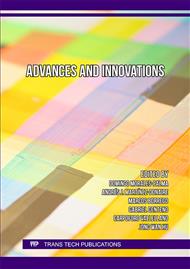[1]
S.N.A.B. Safri, M.T.H. Sultan, M. Jawaid, Damage analysis of glass fiber reinforced composites, in M. Jawaid, M. Thariq, N. Saba (Eds.), Durability and Life Prediction in Biocomposites, Fibre-Reinforced Composites and Hybrid Composites, Woodhead Publishing-Elsevier, Cambridge, USA, 2019, pp.133-147.
DOI: 10.1016/b978-0-08-102290-0.00007-6
Google Scholar
[2]
I.M. Alarifi, A Review on Factors Affecting Machinability and Properties of Fiber-Reinforced Polymer Composites, J. Nat. Fibers 20(1) (2023) 2154304.
DOI: 10.1080/15440478.2022.2154304
Google Scholar
[3]
J.P. Davim, P. Reis, V. Lapa, C.C. António, Machinability study on polyetheretherketone (PEEK) unreinforced and reinforced (GF30) for applications in structural components, Compos. Struct. 62(1) (2003) 67-73.
DOI: 10.1016/s0263-8223(03)00085-0
Google Scholar
[4]
V.N. Gaitonde, S.R. Karnik, F. Mata, J.P. Davim, Modeling and Analysis of machinability characteristics in PA6 and PA66 GF30 polyamides through artificial neural network, J. Thermoplast. Compos. Mater. 23(3) (2010) 313-336.
DOI: 10.1177/0892705709349319
Google Scholar
[5]
R. Domingo, M. García, A. Sánchez, R. Gómez, A sustainable evaluation of drilling parameters for PEEK-GF30, Materials 6(12) (2013) 5907-5922.
DOI: 10.3390/ma6125907
Google Scholar
[6]
N.A. Fountas, I. Ntziantzias, N.M. Vaxevanidis, Multi-objective optimization of cutting parameters for drilling PA66-GF30 glass fiber reinforced polyamide by employing genetic algorithms, J. Manuf. Technol. Res. 10(1-2) (2018) 1-16.
DOI: 10.4028/www.scientific.net/msf.766.37
Google Scholar
[7]
R. Domingo, B. de Agustina, M.M. Marin, A multi-response optimization of thrust forces, torques, and the power of tapping operations by cooling air in reinforced and unreinforced polyamide PA66, Sustainability 10(3) (2018) 889.
DOI: 10.3390/su10030889
Google Scholar
[8]
R. Domingo, B. de Agustina, M.M. Marín, Study of drilling process by cooling compressed air in reinforced polyether-ether-ketone, Materials 13(8) (2020) 1965.
DOI: 10.3390/ma13081965
Google Scholar
[9]
M.K. Nor Khairusshima, I.S.S. Sharifah, Study on tool wear during Milling CFRP under dry and chilled air machining, Procedia Engineering 184 (2017) 78-89.
DOI: 10.1016/j.proeng.2017.04.073
Google Scholar
[10]
R. Domingo Navas, J. Ayllón Pérez, M. Rodríguez-Martín, B. de Agustina Tejerizo, Estudio de la fuerza de avance y la circularidad de los agujeros en el taladrado criogénico de materiales compuestos con aramida, in Proceedings XV Congreso Iberoamericano de Ingeniería Mecánica (CIBIM) Vol. 2, Universidad Politécnica de Madrid, Madrid, 2022, pp.723-731.
DOI: 10.5944/bicim2022.327
Google Scholar
[11]
A. Shokrani, H. Leafe, S.T. Newman, Cryogenic drilling of carbon fibre reinforced plastic with tool consideration, Procedia CIRP 85 (2019) 55-60.
DOI: 10.1016/j.procir.2019.10.008
Google Scholar
[12]
U. Koklu, S. Morkavuk, C. Featherston, M. Haddad, D. Sanders, M. Aamir, D.Y. Pimenov, K. Giasin, The effect of cryogenic machining of S2 glass fibre composite on the hole form and dimensional tolerances, Int. J. Adv. Manuf. Technol. 115 (2021) 125–140.
DOI: 10.1007/s00170-021-07150-y
Google Scholar
[13]
R. Domingo, B. de Agustina, J. Ayllón, Study of drilled holes after a cryogenic machining in glass fiber-reinforced composites, Appl. Sci. 12(20) (2022) 10275.
DOI: 10.3390/app122010275
Google Scholar
[14]
J. Ge, W. Zhang, M. Luo, G. Catalanotti, B.G. Falzon, C. Higgins, D. Zhang, Y. Jin, D. Sun, Multi-objective optimization of thermoplastic CF/PEKK drilling through a hybrid method: An approach towards sustainable manufacturing, Compos. Part A Appl. Sci. 167 (2023) 107418.
DOI: 10.1016/j.compositesa.2022.107418
Google Scholar
[15]
D. Geng, Y. Liu, Z. Shao, Z. Lu, J. Cai, X. Li, X. Jiang, D. Zhang, Delamination formation, evaluation and suppression during drilling of composite laminates: A review, Compos. Struct. 216 (2019) 168-186.
DOI: 10.1016/j.compstruct.2019.02.099
Google Scholar
[16]
D.N. Rodrigues da Silva, Image processing methodology for assessment of drilling induced damage in CFRP, Master´s Thesis, Faculdade de Ciências e Tecnologia, Universidade Nova de Lisboa, 2013.
Google Scholar
[17]
M.H. Kutner, C.J. Natchtsheim, J. Neter, W. Li, Applied Linear Statistical Models, 5th ed.; McGraw-Hill Irwin: New York, NY, USA, 2005.
Google Scholar
[18]
M.P. Wand, M.C. Jones, Kernel Smoothing; Chapman and Hall/CRC: Boca Raton, FL, USA, 1994.
Google Scholar
[19]
V.K. Rohatgi, A.K.M. Ehsanes Saleh, An Introduction to Probability and Statistics, 3rd. ed.; John Wiley & Sons: Hoboken, NJ, USA, 2015.
Google Scholar
[20]
Information on: Statgraphics.net (accessed on 20 January 2023).
Google Scholar



